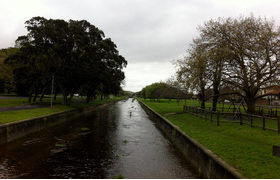What about rainwater harvesting?
30 October 2017 | Story Piotr Wolski. Photo Michael Coghlan via Flickr.
The winter rains of 2017 are effectively finished. Recent analyses indicate that, with current use and without further interventions, water currently stored in the Western Cape’s water supply system dams will not last until the next significant rains, which are expected only in June/July 2018.
Solutions are being sought both through the aggressive reduction of water use to make current dam storage last as long as possible and through the development of alternative water sources. The former has started with the reduction of water pressure, which will effectively cut off water supply to houses in higher areas. In addition to this, unscheduled water rationing (‘water loadshedding’) is looming. The efforts to implement alternative water sources progresses slowly.
The question then remains whether there is something that we can do at the household level to cope with rationing, which will likely increase in intensity as we get closer to the end of the dry season in the first half on 2018.
The available options are unfortunately limited. Drilling a private borehole is a possible solution, but one that is available to only the richest in society (borehole prices currently hover around R80 000–R120 000).
Capturing rainwater is a more accessible solution. All you need is a roof to capture the rain and a tank to store the water. Roofs on most homes are suitable for harvesting the rain, and rainwater tanks are much cheaper than boreholes (from around R2 000 and up depending on volume and supplier). The tanks are, however, currently difficult to come by as the demand is outstripping the supply – waiting time is typically over a month.
However, with rainy season finished, is there a point of investing in a tank and installation to capture rain?
The rainwater harvesting calculator
The Water Harvesting Tool, which was developed by the Climate System Analysis Group (CSAG) at UCT with funding from the Water Research Commission, helps you to understand how rainwater harvesting works. It also allows you to calculate how much water can be obtained from a rooftop water harvesting system at a particular location, ie your home or business.
The calculator is intended to aid the design of a water-harvesting system for long-term use rather than for emergency applications, but it can also help you to gauge whether rainwater harvesting will be worthwhile in the coming months. It will also be helpful if you decide to continue using rainwater harvesting after the current drought.
The calculator is not based on a forecast, so the information that it provides is based only on possible future rainfall, which is estimated from longer-term rainfall values that have been recorded in the past. Importantly, the rainfall data that the calculator uses is locally specific.
So what can we learn from this calculator?
Let’s say that you live in Bellville in a small-to-medium house with a roof that covers an area of 100 square metres. How much rainwater can you expect to harvest in the next few months?
Below is one of the figures that the calculator provides for your place. It shows the amount of rainwater in kilolitres, or thousands of litres, that you would have captured in each month of the year, in an average year. It also shows the wettest and driest months recorded in the last 30 years. Rainfall in the forthcoming months will very likely fall into the latter range.

Firstly, as you can see, you will probably not harvest much rainfall in the period between November 2017 and February 2018, but you might be able to harvest some water during March, April and May 2018. In the worst case scenario, if these months are dry, you will not capture any water. Unfortunately, we cannot tell how likely that worst case scenario is.
However, if March, April and May turn out to have average rainfall, you might be able to capture from two to five kilolitres of water per month. This translates into 70 to 170 litres per day (per household, not per person). It is very little, but if the taps run dry, having this water available will be a considerable relief.
Considering that the period from March to May will likely be the crunch months for Cape Town’s water supply, trying to capture that water might be a winning bet ...
 This work is licensed under a Creative Commons Attribution-NoDerivatives 4.0 International License.
This work is licensed under a Creative Commons Attribution-NoDerivatives 4.0 International License.
Please view the republishing articles page for more information.
Cape Town water crisis
At UCT our researchers have been analysing the causes of the current drought, monitoring water usage on campus and in the city, and looking for ways to save water while there is still time. As part of UCT’s water-saving campaign, all members of the campus community are encouraged to reduce their water use by half, which will help Cape Town to meet its water-use goals and ensure a water-sustainable university in the future.



























